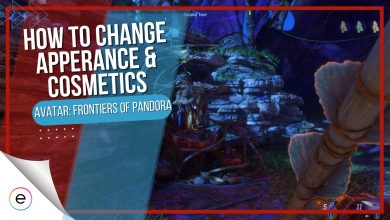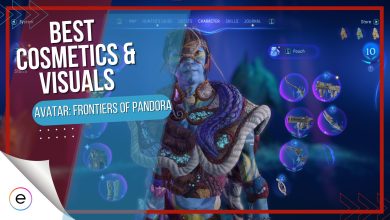Avatar Frontiers of Pandora is a beautiful game, but you can make it even better by applying these best settings for optimal performance. Avatar Frontiers of Pandora requires a beefy PC to run optimally. So, if you’re facing frame drops or hiccups running the game, you can also use these settings to fix them. I’ve experimented with various settings and found these to be the most optimal for performance and FPS.
I’ve benchmarked Avatar Frontiers Of Pandora on a PC with the following specs:
- OS: Windows 11 Pro 23H2
- System: Lenovo Legion 7i Laptop
- CPU: Intel i7-11800H
- GPU: NVIDIA RTX 3070 8GB
- RAM: 32GB DDR4
- Storage: Samsung 1TB SSD Gen 4
You’ll at least need an AMD Ryzen 5 3600 or Intel i7-8700K CPU, AMD RX 5700 or Intel Arc A750 or Nvidia GTX 1070 GPU, and 16 GB RAM to run Avatar.
The following settings will have the most impact on your in-game FPS:
- Shadows Quality
- Sun Contact Shadows
- Spot Shadows
- Spot Shadows Resolution
- Shadow Proxies
- Diffuse Reflections
- Environment Reflection Quality
- BVH Quality
- Micro Detail Quality
The graphical fidelity of Avatar is truly breathtaking, but it’s also an unoptimized game. I’ve encountered FPS drops in the game, especially in vegetation-dense areas. The game’s performance is also quite bad as I was barely touching 45 FPS with high settings and DLSS set to quality. Our Avatar reviewer Huzaifa had to play the game on 1080p resolution on high settings just to maintain 60 FPS.
Best Video Settings
Before moving on to the more technical graphic settings, let’s quickly optimize the video settings. Here’s the summarized version of all the settings you need to tweak.
Summary of Video Settings
| Windowed Mode | Fullscreen |
| Aspect Ratio | Native |
| Resolution | Highest Available |
| Refresh Rate | Your Monitor’s Max |
| Monitor | Your Primary Monitor |
| Temporal Upscaler | FSR 3/DLSS |
| Frame Generation (FSR 3) | On |
| Scaling Quality (DLSS) | Quality |
| Scaling Mode | Fixed |
| V-Sync | Off |
| Frame Rate Limit | Off |
Out of these settings, Temporal Upscaler and V-Sync stand out. I always recommend that you keep V-Sync off unless you suffer from screen tearing. As for Temporal Upscaler, if you don’t have the latest AMD or NVIDIA GPUs, then you can keep that setting on Temporal Anti-Aliasing.

If you want to know more about each setting and what it does, refer to these detailed explanations.
Windowed Mode: Fullscreen
I always prefer to keep the window mode set to fullscreen, and I recommend that you do the same. Fullscreen mode will minimize your input delay and optimize your refresh rate. While Avatar Frontiers of Pandora is not a competitive game, you can still improve your overall gameplay experience by reducing the input delay.
Aspect Ratio: Native
This should be pretty self-explanatory. There’s no need to use any aspect ratio that isn’t your monitor’s native. Doing so will give you an inconsistent gameplay experience and might cut out important visuals.
Resolution: Highest Available
Picking the highest available resolution is important to get the most out of your display. However, if your PC cannot handle your monitor’s highest resolution, you can always lower it according to your performance.
Refresh Rate: Your Monitor’s Max
I recommend picking your monitor’s maximum refresh to get the best experience. If you go above what your monitor can handle, you will get screen tearing. On the other hand, if your PC is struggling with your monitor’s max refresh rate, you can lower it.
Temporal Upscaler: FSR 3/DLSS
In the simplest terms, DLSS makes your graphics look better by taking low-resolution frames and then using AI to make them look much better. FSR does something similar but without the use of hardware-based AI tools. However, the results from both DLSS and FSR are similar. They both can help improve your graphics without using up extra processing power from your PC.
I always recommend using FSR 3 or DLSS if your GPU supports it. It’s completely up to your personal preference to choose between FSR 3 or DLSS, as they both work great.

Frame Generation: On
Frame Generation is a feature that uses AI to generate frames when your PC fails to do so. It can have a massive impact on your overall FPS and also fix frame drops. Many reviewers and videos might slow down or screenshot the display to try to fault frame generation. However, in my opinion, you can’t tell the difference in real-time.
This is why I recommend that you keep Frame Generation on.
Scaling Quality: Quality
This is a control option for DLSS that allows you to choose how much resolution you want it to lower. Once it lowers the resolution, it will scale it back up artificially. You can choose from 4 options. These include quality, Balanced, Performance, and Ultra Performance.
In my experience, the Quality option worked the best. However, you can experiment with the other options and see which one looks the best and puts the least load on your PC.
Scaling Mode: Fixed
This setting allows you to choose the mode you want to use when your graphics are being upscaled. I recommend using the Fixed scaling option because you are already using Scaling Quality with DLSS. The other option is the Biased scaling mode, which will try to bias your resolution towards 4K. However, I don’t recommend this unless you have a beefy PC.
V-Sync: Off
V-Sync matches the frame rate of your game with your monitor’s refresh to prevent screen tearing. The downside is that it can cause a lot of input lag. As long as you aren’t getting screen tearing, there is no reason to enable V-Sync.
Frame Rate Limit: Off
There is no reason to go out of your way to limit the amount of frames you get. So, I suggest that you always keep the frame limit off unless you have specific circumstances.
Best Graphic Settings
Now, this is the more detailed and technical part of the Avatar Frontiers of Pandora best settings guide. Surprisingly, the game offers many different settings that can affect your visual experience. With these settings, I’ve mainly focused on improving FPS and performance while minimizing visual decay. This means that if your PC can handle it, feel free to bump up a few settings.
Overview of Best Graphics Settings
| Graphics Quality | Custom |
| Motion Blur | Off |
| Depth of Field | Off |
| Shadows Quality | Medium |
| Sun Contact Shadows | Low |
| Spot Shadows | Medium |
| Spot Shadows Resolution | Medium |
| Shadow Proxies | Off |
| Specular Reflections | High |
| Diffuse Reflections | Medium |
| Environment Reflection Quality | Medium |
| Volumetric Clouds | High |
| Volumetric Fog | High |
| Extra Streaming Distance | 5 |
| Object Detail | Medium – High |
| BVH Quality | Medium |
| Micro Detail Quality | Medium |
| Particle Detail | High |
| Scatter Density | Medium |
| Dither Fade | On |
| Spotlight Projection Resolution | 512 |
| Destruction Quality | High |
| Terrain Tessellation | High |
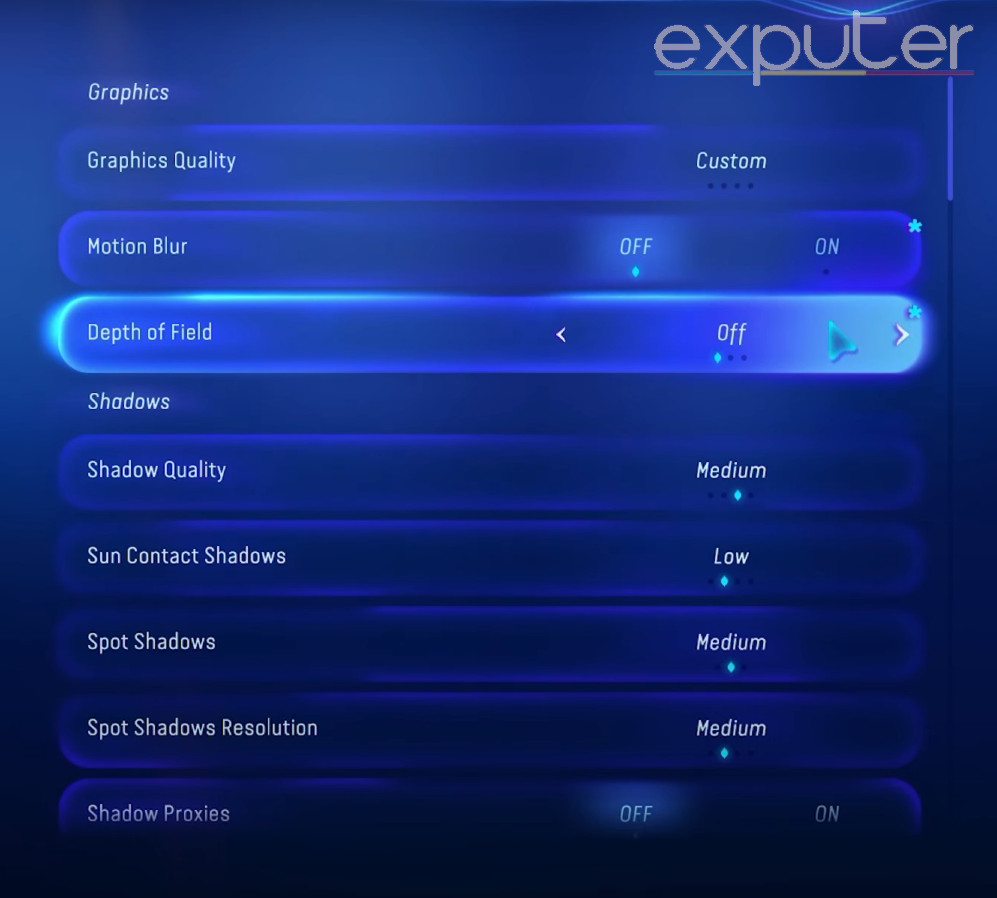
You can find more details on each setting below.
Graphics Quality: Custom
These are graphic presets that you can use if you don’t want to mess around with the settings. If you are confident that your PC can handle the highest settings, simply select Very High here. However, for the average player, I recommend following the settings proceed below. This will automatically set the Graphics Quality as custom.
Motion Blur: Off
Motion Blur will blur objects as you move to replicate realism. However, I always prefer to keep Motion Blur off because it can look very odd at higher frame rates. Additionally, some players might experience motion sickness from this feature.
Depth Of Field: Off
Depth of field tries to achieve a realistic focus by making some objects clearer than others. Similar to motion blur, this feature can sometimes make your graphics look strange. This is why you should keep it off.
Shadows Quality: Medium
This setting allows you to adjust the quality of the shadows in-game. I believe medium to be the best setting for this to optimize performance without sacrificing visual quality.

Sun Contact Shadows: Low
These are the shadows that are cast by the Sun. There are not a lot of scenarios where you would focus a lot on these types of shadows. So, I recommend keeping this setting low.
Spot Shadows: Medium
These are the shadows cast by spotlight sources. These shadows can make your visuals pop a lot. As such, keeping them at medium is a good idea.
Spot Shadows Resolution: Medium
This setting dictates the resolution of your spot shadows. Again, I recommend picking a medium for this.
Shadow Proxies: Off
Shadow Proxies can lower the overall power that your PC needs to process shadows. It achieves this by creating a specific low-poly shadow instead of using the high-poly version of the object that is casting the shadow.
I’ve already listed the most optimal settings for in-game shadows, which is why I don’t recommend turning Shadow Proxies on. However, if you want to squeeze out every bit of performance, you can turn this setting on.
Specular Reflections: High
Specular Reflections are the bright parts of a shiny object. This setting can greatly enhance your visual quality, which is why I recommend keeping this high. In my experience, Specular Reflections didn’t use up an excessive amount of processing power either.
Do note that if your GPU does not support Ray Tracing, this setting will greatly impact your performance. In that case, I recommend keeping Specular Reflections low.
Diffuse Reflections: Medium
This is the same thing as a spectral reflection but for rough surfaces. I recommend medium for this because reflections on rough surfaces are barely noticeable.
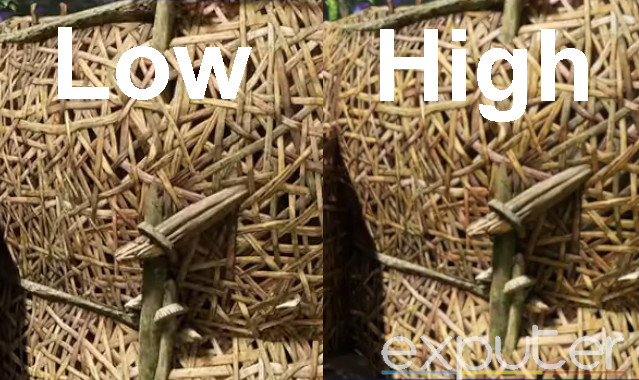
Environment Reflection Quality: Medium
These are reflections for particularly big objects. Again, the medium is the sweet spot here as well.
Volumetric Clouds: High
This setting decides how good the clouds in your environment look. Realistic-looking clouds can make or break the visual experience. Keep Volumetric Clouds high not to sacrifice any visual quality.
Volumetric Fog: High
Volumetric Fog is responsible for creating the dust, smoke, or fog effect. It single-handedly adds density and realism to the scene. I suggest that you make this setting high.
Extra Streaming Distance: 5
Extra Streaming Distance decides how far you can see. The higher you make this, the more objects and environments need to be rendered at one time. I found 5 to be the best option because it keeps the in-game depth without overloading your PC.
Object Detail: Medium – High
As the name suggests, this setting decides how many details the objects in Avatar Frontiers of Pandora have. This setting decides the details on all objects, which is why I recommend keeping this at high. However, if your PC starts dropping frames, feel free to lower it to medium.
BVH Quality: Medium
BVH Quality affects the Ray Tracing graphics and can greatly enhance them. However, it also puts a lot of load on your CPU. You can safely keep BVH Quality at medium. If you still encounter issues, make it low.
Microdetail Quality: Medium
Microdetail Quality decides the amount of smaller objects that can be viewed on a bigger object. An example of this is grass. Keep Microdetail quality at medium for optimal performance.
Particle Detail: High
This setting controls the quality and quantity of all the particles displayed on your screen. Lowering Particle Detail can make the screen look blurry, which is why you must keep this setting high.
Scatter Density: Medium
Scatter Density will decide how dense the objects scattered throughout the in-game world are. Medium is the best option here.
Dither Fade: On
Dither Fade will naturally blur out objects in your view to create a more natural visual experience. It can also make it easier to walk through objects without disrupting your view. My suggestion would be to keep Dither Fade on.
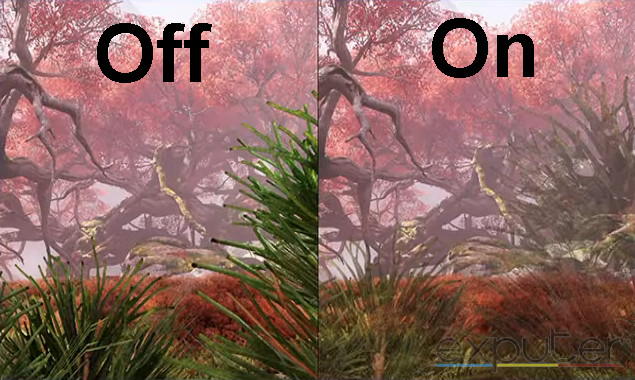
Spotlight Projection Resolution: 512
This option determines how clear or detailed the textures look when spotlights shine them on surfaces. The midpoint is 512, which is what I recommend. However, you are free to adjust this setting according to what you prefer and what your PC can handle.
Destruction Quality: High
Destruction Quality will decide how much quality and quantity is in the destruction splatter. In my opinion, having beautiful destruction is an important part of your visual experience. Therefore, I suggest keeping Destruction Quality High.
Terrain Tessellation: High
Terrain Tessellation adds additional depth and details to the ground around you. Keeping this high will greatly enhance your graphics. Of course, if you notice frame drops, you can always lower this setting.
My Thoughts
Avatar Frontiers of Pandora is one of the most visually impressive games. However, as impressive as it is, you still need a relatively strong PC to run the game comfortably. Some players might even meet the hardware requirements but still encounter frame drops. This is why I have created this Avatar Frontiers of Pandora best settings guide to boost your performance without making the game look like pixels.
If you are encountering crashing problems, make sure to check out Avatar: Frontiers Of Pandora Crashing.
You can also increase FPS further through these general optimization guides:
Thanks! Do share your feedback with us. ⚡
How can we make this post better? Your help would be appreciated. ✍
This game is demanding as heck as my 1080 could barely manage 50 FPS.
